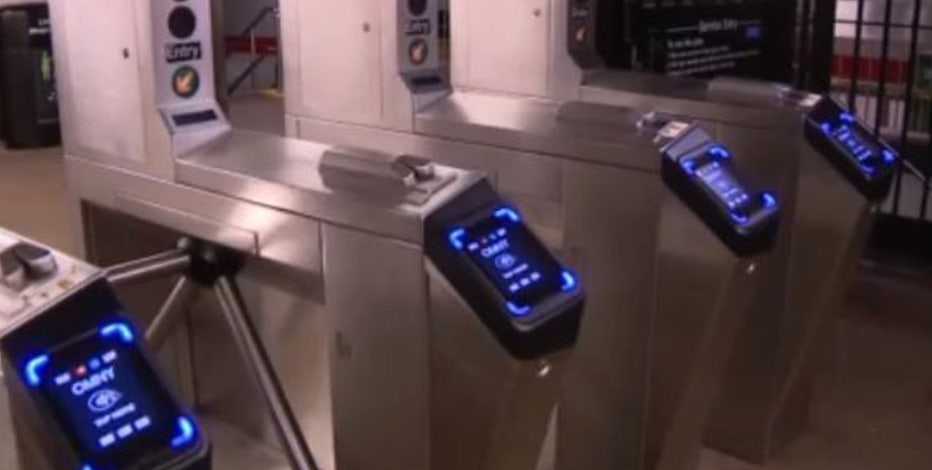Subway accessibility: Disability advocates have praise and criticism for MTA’s recent actions on elevators
NEW YORK - The New York City subway has been called the great equalizer.
Every day, close to 4 million people use the transportation system and the vast majority use the stairs to get to the platform.
"That's the lifeblood to get you among these five boroughs," Blair-Goldensohn said.
"I love taking the subway because, you know, it runs all the time, it was fast, it was cheap, and it was for everyone, I thought," Blair-Goldensohn, who uses a wheelchair, continued.
Fourteen years ago this month, Blair-Goldensohn was walking through Central Park when a dead tree limb fell on his head. He was in a coma for weeks and woke up a paraplegic.
"It's a little slower, but you can do so much. I mean, I hand cycle, I play tennis, I try to go to baseball games, do things with my kids, but just taking the subway, that was so hard because there are so few elevators," he said.
Featured
Some OMNY users mistakenly overcharged
Some commuters who use the OMNY system were charged $2.90 instead of the current fare of $2.75.
In the largest subway system in the largest city in the country, only around a quarter of New York City's nearly 500 have elevators or ramps that make them fully accessible to people with mobility disabilities.
But it is improving.
Federal and state judges recently gave final approval of a settlement to two class action lawsuits that alleged the MTA and NYCTA discriminated against people with mobility disabilities.
The biggest win, advocates said, was the fact that the MTA is now "required" to make sure 95% of stations have elevators by the year 2055. While that is more than 30 years away, Blair-Goldensohn said it’s still a huge victory.
"Yeah, that's a long time. I may not be here. A lot of people aren't going to be, but is for the next generation," he said.
But the settlement also lays out benchmarks for progress. For example, by 2035, half the stations must have elevators. This settlement absolutely represents a commitment far beyond any that the MTA has made in the past.
Rebecca Rodgers is an attorney with Disability Rights Advocates, which brought the lawsuit.
"This settlement will dramatically increase the accessibility of the system as a whole, and it will dramatically increase the amount of monetary investment that is being put toward subway accessibility," Rodgers said.
But the elevator issue doesn't end there.
"We see these yellow gates at broken elevators way too often. More than 30 stations are out on average a day. That's a safety emergency – full stop," said Blair-Goldensohn.
Featured
'This is a plan we cannot accept': Gov. Murphy sues Federal Highway Admin over congestion pricing
Gov. Phil Murphy says the new congestion plan is one that he cannot accept, citing the financial and environmental burdens it would have on New Jersey commuters.
At a recent MTA board meeting, Blair-Goldensohn and disability rights advocates focused their attention on another lawsuit filed six years ago regarding the MTA’s failure to maintain the elevators that already exist.
"We're really trying to rectify a lot of the wrongdoings that happened in previous leaderships previous administrations, a lack of investment for our most vulnerable populations and our riders with the highest needs," Arroyo said.
"What it sounds like I'm hearing is you're conceding the MTA has dropped the ball on this," FOX 5's Chris Welch asked.
"Absolutely no, no denial," Arroyo replied.
But Arroyo said today, accessibility is the MTA's number two priority, second only to safety.
In regard to the settlement that will require 95% of stations to have elevators by 2055, Arroyo said it's a vote of confidence from the disability community.
But Blair-Goldensohn said he isn't that confident, and he said he doesn't believe Arroyo when he says current leadership is righting the wrongs of the past.
"Frankly, no I would say. But I don't think he's being disingenuous. I think it's talking the talk that he doesn't have. He and even Jana Lieber don't have the power to walk the walk," Blair-Goldensohn said.
Blair-Goldensohn said if they're ever going to see elevator maintenance improved and for accessibility to truly be an MTA priority, the governor needs to make it one. He said they've requested meetings with Gov. Kathy Hochul but so far, have been unsuccessful.
In a statement, Hochul said that "no New Yorker should have to worry about whether or not they can safely access public transportation."
Hochul said her administration is working to make sure New York State is accessible to all, but when asked directly if she would pledge to make elevator maintenance a priority, her spokesperson declined to answer.
But Blair-Goldensohn still has hope that one day the subway system will serve all New Yorkers.





